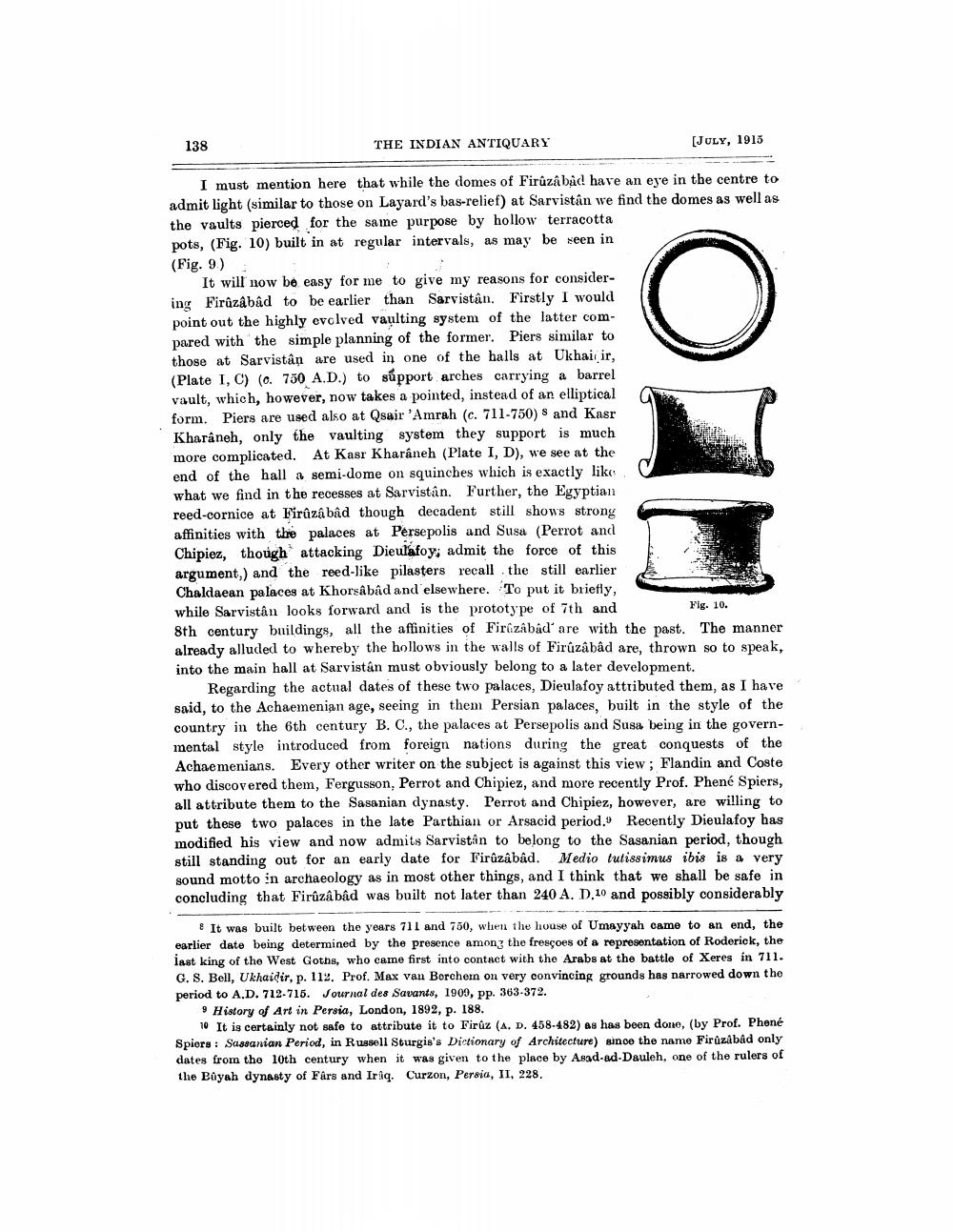________________
138
THE INDIAN ANTIQUARY
(JULY, 1915
I must mention here that while the domes of Firüzâ båd have an eye in the centre to admit light (similar to those on Layard's bas-relief) at Sarvistán we find the domes as well as the vaults pierced for the same purpose by hollow terracotta pots, (Fig. 10) built in at regular intervals, as may be seen in (Fig. 9)
It will now be easy for me to give my reasons for considering Firûzâbâd to be earlier than Sarvistân. Firstly I would point out the highly evolved vaulting system of the latter compared with the simple planning of the former. Piers similar to those at Sarvistân are used in one of the halls at Ukhai, ir, (Plate I, C) (0.750 A.D.) to support arches carrying a barrel vault, which, however, now takes a pointed, instead of an elliptical form. Piers are used also at Qsair 'Amrah (c. 711-750) 8 and Kasr Kharaneh, only the vaulting system they support is much more complicated. At Kasr Kharaneh (Plate I, D), we see at the end of the hall a semi-dome on squinches which is exactly like what we find in the recesses at Sarvistân. Further, the Egyptian reed-cornice at virůzâbâd though decadent still shows strony affinities with the palaces at Persepolis and Susa (Perrot and Chipiez, though attacking Dieulafoy; admit the force of this argument,) and the reed-like pilasters recall the still earlier Chaldaean palaces at Khorsâbâd and elsewhere. To put it briefly, while Sarvistân looks forward and is the prototype of 7th and
Fig. 10. 8th century buildings, all the affinities of Firozabad' are with the past. The manner already alluded to whereby the hollows in the walls of Firůzâbâd are, thrown so to speak, into the main hall at Sarvistán must obviously belong to a later development.
Regarding the actual dates of these two palaces, Dieulafoy attributed them, as I have said, to the Achaemenian age, seeing in them Persian palaces, built in the style of the country in the 6th century B. C., the palaces at Persepolis and Susa being in the governmental style introduced from foreign nations during the great conquests of the Achaemenians. Every other writer on the subject is against this view ; Flandin and Coste who discovered them, Fergusson, Perrot and Chipiez, and more recently Prof. Phené Spiers, all attribute them to the Sasanian dynasty. Perrot and Chipiez, however, are willing to put these two palaces in the late Parthian or Arsacid period.9 Recently Dieulafoy has modified his view and now admits Sarvistân to belong to the Sasanian period, though still standing out for an early date for Firůzâbâd. Medio tutissimus ibis is a very sound motto in archaeology as in most other things, and I think that we shall be safe in concluding that Firûzâbâd was built not later than 240 A. D.10 and possibly considerably
8 It was built between the years 711 and 750, when the house of Umayyah came to an end, the earlier date being determined by the presence among the frescoes of a representation of Roderick, the last king of the West Goths, who came first into contact with the Arabs at the battle of Xeres in 711. G. S. Bell, Ukhaidir, p. 112. Prof. Max van Borchern on very convincing grounds has narrowed down the period to A.D. 712-715. Journal des Savants, 1909, pp. 363-372.
9 History of Art in Persia, London, 1892, p. 188.
10 It is certainly not safe to attribute it to Firuz (A. D. 458.482) as has been done, (by Prof. Phené Spiers : Sassanian Period, in Russell Sturgis's Dictionary of Architecture) since the name Firüzâbâd only dates from the 10th century when it was given to the place by A83d-ad-Dauleh, one of the rulers of the Bûyah dynasty of Fårs and Iraq. Curzon, Persia, II, 228.




